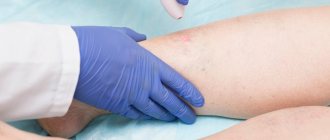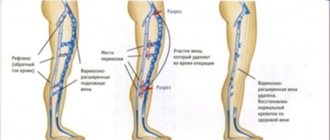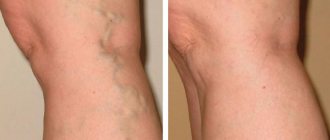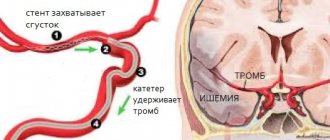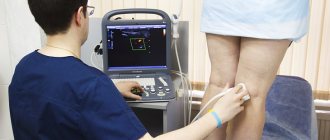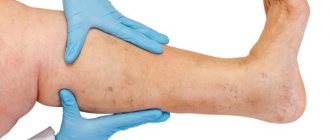Surgery to remove varicose veins on the legs (phlebectomy of the veins of the lower extremities) is one of the oldest forms of surgical treatment of varicose veins of the lower extremities. The earliest description of the procedure was written by Aulus Cornelius Celsus, a Roman medical historian. The first description of phlebectomy using hooks was published in 1545. Modern combined phlebectomy was developed around 1956 by a Swiss dermatologist named Robert Müller.
Microphlebectomy is the medical term used for the procedure of removing an enlarged superficial vein through a tiny incision in the leg. The incisions are so small that they often do not require stitches to close them. A small piece of masking tape is usually enough to cover it. The procedure also helps eliminate pain and improves the appearance of the legs. Surgery for varicose veins of the lower extremities can be used in combination with other procedures such as EVLT (endovenous laser therapy) and sclerotherapy.
Phlebologists at our center perform surgery on the legs for varicose veins, as suggested by the German professor Varadi, who developed his own instruments for performing the operation and formulated the basic postulates of modern microphlebectomy through a puncture. This method has excellent cosmetic results, is painless and does not require hospitalization. At the Innovative Vascular Center, this operation on veins for varicose veins is performed perfectly, and the price of the intervention is affordable for everyone.
Very cosmetic
In most Russian hospitals, varicose veins on the legs are removed, both through a large incision in the groin (crossectomy) and through large incisions on the legs according to Narat or Linton. The consequences of such a combined phlebectomy are not satisfactory for most patients. Our technology involves minimal intervention through skin punctures that leave virtually no scars. The dilated vein is “evaporated” with a laser without incisions. Varicose veins and nodes are eliminated with microphlebetomy and Foam-Form sclerotherapy. The use of a minimally invasive technique involves significantly less tissue trauma than “classical” combined phlebectomy; patient reviews of the postoperative period are very good.
Contraindications
Phlebectomy is not recommended in the following cases:
- During pregnancy and lactation.
- If the patient has serious diseases of the cardiovascular system (coronary artery disease, recent myocardial infarction, stroke, heart defects with severe hemodynamic impairment).
- If the skin in the area of surgical manipulation is affected by eczema in the acute stage, purulent formations.
- In case of acute thrombosis of the superficial veins of the lower extremities, planned operations are not performed; in case of life-threatening thrombosis of the deep veins, emergency surgical interventions are performed such as crossectomy (ligation of the great saphenous vein at the point of its transition into the common femoral vein, plication (special technique for suturing veins) of the deep veins) .
- In the presence of any infectious diseases in the acute stage (ARVI, influenza)
- With exacerbation of chronic diseases.
Under local anesthesia
The operation to remove veins for varicose veins is performed under local anesthesia, which allows you to fully numb the surgical field with a weak solution of local anesthetic - novocaine or lidocaine. The result of surgery should be the elimination of varicose veins with an excellent aesthetic result. The meaning of aesthetic phlebectomy is to remove varicose veins through punctures, but not skin incisions under local anesthesia. Only subtle scars remain, which are practically invisible after 3-6 months. Phlebologists at the Innovative Vascular Center have mastered this technique to perfection.
Indications
In most cases, this manipulation is performed for varicose veins in an advanced stage.
Indications include:
- Protruding, swollen veins that are visible to the naked eye.
- Greater tortuosity of blood vessels.
- Severe pain and heaviness in the lower extremities, which significantly reduces the quality of life.
- Complications of varicose veins (trophic ulcers, thrombophlebitis).
The main goals of vein surgery:
- Relief from painful and uncomfortable sensations.
- Normalization of blood circulation.
- Prevention of complications and undesirable consequences.
- Restoring the aesthetic appearance of the skin of the extremities.
After phlebectomy, it is possible to achieve all the goals, since varicose veins are completely removed, the blood flow in them stops, and blood begins to circulate only through healthy veins. At the same time, all disturbing symptoms disappear. Please note that the decision about the advisability of surgical intervention is made only by the doctor.
Without hospitalization and sick leave
When treating varicose veins in our clinic, hospitalization is not necessary. Complex cases of varicose veins are treated by combining laser coagulation and miniphlebotomy. Minimal trauma, as well as a low risk of intervention, allow this operation to be performed in a day hospital. After modern miniphlebectomy, the patient can be sent home half an hour after the intervention. In the postoperative period, you need to lead an active lifestyle, active walking is encouraged. Temporary incapacity for work usually lasts no more than 7 days, then it is possible to begin work.
Alternative techniques (INNOVATION IN PHLEBOLOGY)
The most modern achievements of phlebology are innovative techniques:
- radiofrequency vein obliteration (medicaltechnologies VNUS Closure)
- endovasal laser obliteration (EVLO), performed using a radial light guide.
- foam-form sclerotherapy (or so-called foam sclerotherapy).
Also considered the gold standard for the treatment of varicose veins is:
All these methods are significantly superior to the surgical method of treating varicose veins.
Preparing for treatment
Before surgery for varicose veins in the legs, patients should stop taking aspirin or aspirin-related medications for a week before the procedure. They should not eat or drink after midnight on the day of surgery. You should not apply any moisturizers or tanning lotions on the day of your procedure. The patient should arrive at the surgery center approximately one and a half hours before the procedure. He is asked to walk around the room or corridor for about 20 minutes so that the subcutaneous nodes appear. The surgeon marks the contours of varicose conglomerates with a marker. Ultrasound scanning is performed for preoperative marking.
How is the treatment carried out?
Skin punctures are made with a needle at points according to the preoperative markings. The varicose node must be carefully isolated along the vein with a special hook, and then it is removed by pulling it out through a small puncture. The video shows an operation to remove varicose veins through micropunctures on the legs. Sutures are not required if the doctor uses minimal incisions (1-3 mm) and good postoperative compression. This eliminates the consequences in the form of noticeable scars and seals in the incision area. Experienced surgeons remove extensive venous networks in both legs in one session lasting from 60 to 120 minutes. Additional sclerotherapy for residual varix and telangiectasia allows you to remove small vessels after phlebectomy. With laser phlebectomy, small punctures are made, and the removal of the vein in small sections minimizes the appearance of blood clots and promotes the best cosmetic effect. This method requires special training of the surgeon. After all extended varicose segments have been removed, a compression bandage must be applied.
Miniphlebectomy
A minimally invasive procedure that is performed under local anesthesia and does not require incisions or long recovery. It is carried out in cases where varicose veins have not progressed to a serious stage, that is, if the main vein is not affected. I remove varicose nodes and single tributary veins. Preparation includes standard examination - ultrasound, ECG, general tests. During the operation, small punctures are made through which access to the affected areas is provided. Healing is fast, there are no stitches or scars. At first, discomfort and postoperative hematomas may persist, which disappear without consequences. It is important that the patient begins to move almost immediately after the intervention. Wearing compression garments and regularly visiting a doctor for examination is mandatory. The risk of complications is minimal.
Make an appointment with a specialist, without queues, at a convenient time
+7
Sign up
Possible complications of phlebectomy
Most minor complications are not dangerous and resolve spontaneously. Varicose veins only recur if the source of venous reflux is not removed using endovenous thermal ablation techniques. Laser phlebectomy involves a combination of methods leading to complete recovery.
What can happen after phlebectomy of the great saphenous vein?
- Bleeding, hematoma formation on the thigh (the formation of bruises depends on the correct selection of compression garments),
- Skin pigmentation along the treated venous trunk.
- Other complications, such as accidental nerve damage with sensory impairment or infection, are rare.
- Sometimes skin necrosis may occur.
- Keloids and hypertrophic scars usually do not occur due to the minimal size of the incisions.
- Deep venous thrombosis is observed in isolated cases, since compression stockings are effective methods of prevention.
Stripping
The operation involves removing the trunk of the saphenous vein, large or small. The main indications for surgery are cosmetic indications for the removal of varicose veins, bleeding from affected veins, swelling and heaviness, chronic venous insufficiency.
Thanks to duplex scanning technology, it is possible to accurately determine the location of the affected areas, so only the part of the trunk that has lost functionality can be removed (in most patients, the lower leg area is not affected). A thin probe is used to treat veins. Several stripping techniques are used, differing in the equipment used to carry it out.
Preparation, as for crossectomy, consists of proper examination and localization of the affected area. No special actions are required on the part of the patient. It is important to prepare compression stockings in advance, as they will need to be put on immediately after surgery. Postoperative recovery takes about four to six weeks, depending on the extent of the procedure and the characteristics of the patient.
Observation after treatment
Regular classic phlebectomy is rarely needed by patients, as it usually requires an overnight stay in the hospital and 2 to 8 weeks at home. After vein removal in the lower extremities in our center, the patient is allowed to exercise, but should not drive a car for at least a day, since distal motor function may be impaired due to prolonged anesthesia, especially after anesthesia in the popliteal region. The patient is advised to walk for about 10-15 minutes before leaving the clinic.
In the future, you will need to take diosmin medications (detralex); it is not recommended to stand in one place for a long time for 2 weeks. This helps minimize the risk of blood clots forming in the deep veins of the leg. A compression bandage prevents post-operative bleeding and reduces the likelihood of pain, bruising and other complications. The bandages are removed 3-7 days after surgery, but the compression stocking should be worn for an additional 2-4 weeks to minimize bruising and swelling. The wearing time depends on the size of the veins removed and the degree of reflux treatment. Stockings can be removed when taking a shower.
Additional sclerotherapy should be postponed for several weeks and done after the postoperative swelling has disappeared. Many spider veins can spontaneously regress and also disappear spontaneously after the varicose veins are removed through outpatient phlebectomy. Patients should avoid early sun exposure because hyperpigmentation may appear at the puncture or incision site.
The patient is advised to monitor for redness, swelling, suppuration, fever and other signs of infection. If these signs appear, you should immediately consult a doctor.
Surgical treatment of varicose veins of the lower extremities, why did we completely abandon it?
As mentioned above, classical surgical treatment of varicose veins is actively used in European medical practice, including Moscow, the Moscow region and other Russian cities.
To the question: why is this, and why use horses when there are already good cars? By using a century-old operation, we lose the following advantages of innovation:
- No ultrasound imaging available. The intervention is controlled through the surgical wound; to improve visibility, it is necessary to enlarge the incision.
- Surgical trauma increases significantly. This not only increases the rehabilitation period, but also affects possible complications and side effects.
- The effectiveness of treatment decreases.
- In most cases, separation of the treating doctor from ultrasound diagnostics.
- Trauma, sometimes significant, at the sites of incisions and phleboextraction sites.
- Pseudo-radicalism. As practice shows, with phlebectomy, with very rare exceptions, significantly fewer varicose veins are removed than using modern techniques.
In the practice of the Moscow City Phlebological Center, we use only the best modern techniques and combined phlebectomy has long been out of place there.

